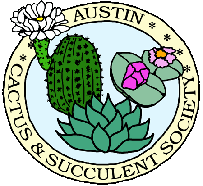7:00 pm - Refreshments and Conversations
7:30 pm - Program: South Africa, Namaqualand, Land of the Halfmens by Woody Minnich
South Africa is considered by many to be the richest region in the world for flowering plants. Within South Africa’s many environments, there is no more enchanted and succulent rich area than that of the Richtersveld. From the coastal fog fed regions to the higher mountains, one can find an amazing diversity of geophytic, miniature and giant species. The areas we will be exploring are from the south near Springbok up to the Richtersveld and the Orange River, and then slightly north into the deserts of Namibia, Namaqualand.
This northern portion of South Africa is also sometimes referred to as the Namaqualand. The original peoples from this general landscape were referred as the Nama. Their homeland environments were quite variable ranging from the very arid inland hills and mountains to the cooler foggy coastal sand dunes. The Nama were a rather nomadic people and thus lived in almost all of these different geologic settings. Rumors have it that the Nama people, when at war with neighboring tribes, would dress the Pachypodium namaquanum’s with hats and robes thus making it appear as if their armies were of greater number. These dressed up plants were referred to as the Halfmens. From a distance, Pachypodium namaquanum is often sparsely branched, thus it can undoubtedly resemble a human figure.
From the south, in the region of Springbok, the succulents are very numerous. These areas are generally of granitic substrate. This granite often takes the form of giant domed inselbergs and is then transformed into scenic sandy valleys and washes. In this region, the Aloes are not as common as some of the Mesembs and Crassulas, but when you do find them, they are very handsome. Aloe melanocantha is often found on mountain tops where it can become deep burgundy red with beautiful black marginal teeth. The spiny Aloe erinacea is also found on the mountain tops where it occasionally forms giant six foot in diameter clusters. The other succulents range from the many species of Pelargoniums, Crassulas, Othonnas, Conophytums, Tylecodons, Avonias, Euphorbias, Lithops and other shrubby Mesembs. Also, bulbs can surely keep one occupied while looking for our prized succulents.
Into the north, the environments become more and more arid. It is here in the Richtersveld that one begins to find many of our most prized succulents, from the statuesque Aloe pillansii to the highly sought Aloe pearsonii. Here, the Monsonias (Sarcocaulons) and the Tylecodons have evolved into some of their most exotic forms. Monsonia paniculina and multifida take center stage and the bonsai forms of Tylecodon pearsonii run a close second. The other Aloes, Conophytums, Crassulas, Larryleachias and Lithops are just a few of the well represented genera to be found in this magical territory.
Come travel with me to the Richtersveld to see its numerous plants and animals as well as its endless beautiful vistas. From the lizards to the Baboons, there is never a dull moment and the iconic Aloe pillansii and dichotoma will leave you with an everlasting memory of this most fascinating landscape.
Woody, Wendell S. Minnich
Woody, as he is commonly known, has been in the cactus hobby for some 47 years and has become well known for his participation and contributions. He has been awarded honorary life membership to ten clubs, as well as, a life member and Friend award with the CSSA (Cactus & Succulent Society of America.) His many leadership roles include: National Show Chairman, Convention Sales Chairman, Convention Speaker coordinator, 2016 Mid-States Conference Co-chair, accredited C & S judge and writer-photographer. He has also served in almost all positions of leadership for many regional clubs and is currently the president of the new Santa Fe C & S club.
Woody is probably best recognized for his many presentations. His photography is considered to be special and his commentary very entertaining and educational. After all, he was a celebrated secondary school teacher for 32 years, where he taught Art, Graphic Arts-Design and Architecture. He has now become a recognized international speaker and has presented at cactus and succulent events all over the world.
He has also authored a number of articles for various newsletters and journals including the CSSA journal and his photographs are also well published. His work is featured in many books including: “The New Cactus Lexicon” Hunt and Charles, “Mammillaria” Pilbeam, and “Echeveria Cultivars” Schulz & Kapitany. Woody is the creator-originator of the first color version of the CSSA journal article “Cacti and Succulents for the Amateur” featuring show plants, shows, and the growers of the pictured plants. He is also often called upon to do new book reviews for the CSSA journal
His involvement in the cactus and succulent world is well represented by his 45 years of field work in regions including: Africa, Argentina, Australia, Bolivia, Brazil, Chile, Madagascar, Mexico, Namibia, New Zealand, Peru, Socotra, the United States and Yemen. He often goes to remote places where few, if anyone, have ever explored and as a result of this field work, he has introduced many new taxa. Also, being a recognized grower, Cactus Data Plants since 1975, Woody has developed strong interests in both succulent plant taxonomy and the many cultivation secrets that help us to grow these unique plants.



